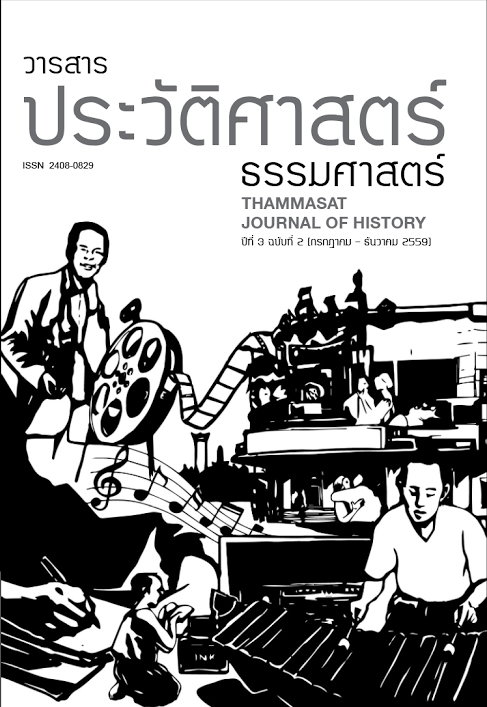อิสตรีและมังกร: ไดโนเสาร์ ผู้หญิงใหม่ และความกังวล ว่าด้วยความเสื่อมทรามในนวนิยายเรื่อง The Lair of the White Worm ของแบรม สโตเกอร์
Main Article Content
บทคัดย่อ
ความรุนแรงอันบังเกิดจากการมองแกนเวลาเป็นเส้นเดียวและตรงไปข้างหน้าในนวนิยายเรื่อง The Lair of the White Worm ของแบรม สโตเกอร์ นั้นเกิดขึ้นเพื่อต่อต้านพญางูขาว ซึ่งเป็นไดโนเสาร์ที่ยังมีชีวิต และเลดี้ อราเบลลา มาร์ช ตัวละครที่มีลักษณะใกล้เคียงกับ “ผู้หญิงใหม่” ความรุนแรงนี้เองสะท้อนความกังวลเกี่ยวกับควาเสื่อมทรามของเผ่าพันธุ์มนุษย์ ในสมัยวิกตอเรียน ไดโนเสาร์สะท้อนการเสื่อมถอยของเผ่าพันธุ์มนุษย์เนื่องจากนิทรรศการไดโนเสาร์ซึ่งมีชื่อเสียงในสมัยวิกตอเรียนที่ซิเดนแนม พาร์กได้จัดเส้นทางนิทรรศการย้อนกลับไปยังยุคดึกดำบรรพ์ โดยมีรูปปั้นไดโนเสาร์ต่างๆ อยู่ที่ปลายทาง นอกจากนี้ พญางูขาวในนวนิยายเรื่องนี้ถูกมองว่าเป็นสัตว์ดุร้ายป่าเถื่อน
มีจิตใจแข็งกระด้าง และไม่อาจเห็นอกเห็นใจสิ่งมีชีวิตชนิดอื่นได้ อย่างไรก็ตาม คำบรรยายซากศพของทั้งพญางูและสิ่งที่เชื่อว่าเป็นเหยื่อของพญางู ซึ่งถูกทำลายด้วยตัวละครที่เป็นมนุษย์นั้น แสดงให้เห็นความรุนแรงและ “ความไร้มนุษยธรรม” เพราะความคิดที่ว่าความเห็นอกเห็นใจต่อสัตว์เป็นคุณลักษณะของมนุษย์นั้นเป็นที่แพร่หลายในสหราช
อาณาจักรช่วงศตวรรษที่ 19 เมื่อตัวเรื่องรวมพญางูกับเลดี้ อราเบลลา มาร์ช ผู้มุ่งมั่นจะแต่งงานกับชายฐานะร่ำรวยนั้น เราอาจตีความได้ว่าความกังวลเกี่ยวกับความเสื่อมถ่อยและเสื่อมทรามทำให้นวนิยายเล่มนี้โจมตีผู้หญิงใหม่และผู้หญิงที่เรียกร้องสิทธิเลือกตั้ง เพราะผู้หญิงเหล่านี้ตั้งคำถามกับเพศวิถีของผู้หญิงและอาจไม่คิดมีทายาท ในเมื่อเลดี้ อราเบลลาสามารถรวมร่างกับพญางูได้ด้วย เราจึงอาจตีความได้เพิ่มเติมว่าเธอมีลักษณะเป็นแม่มีลึงค์ ซึ่งท้าทายปิตาธิปไตย ก่อให้เกิดความกังวลเกี่ยวกับการตอนในหมู่ผู้ชาย และทำให้เพศสถานะและเพศวิถีของเธอกำกวม อย่างไรก็ตาม ความเข้มแข็งของพลังอำนาจผู้ชายเพื่อเอาชนะ “สัตว์ร้าย” ในนวนิยายได้ นั้นก็ต้องอาศัยความสัมพันธ์ในกลุ่มเพศเดียวกัน ซึ่งอาจนำไปสู่จุดจบของเผ่าพันธุ์และไม่ให้กำเนิดทายาทเช่นกัน ดังนั้น บทความชิ้นนี้จึงมุ่งหมายที่จะชี้ให้เห็นว่านวนิยายเรื่องนี้ตั้งคำถามกับการสร้างความชอบธรรมให้กับความรุนแรงอันเกิดจากแนวคิดเกี่ยวกับความก้าวหน้าและอนาคต โดยแสดงให้เห็นความย้อนแย้งที่อยู่ใจกลางการรักษาเผ่าพันธุ์ของมนุษย์
Article Details
ลิขสิทธิ์บทความเป็นของผู้เขียนและสงวนสิทธิ์ตามกฎหมาย
ข้อคิดเห็นใดๆ ที่ปรากฏในวารสารนี้เป็นของผู้เขียน คณะกรรมการวารสาร ภาควิชาประวัติศาสตร์ฯ กองบรรณาธิการ ตลอดจนกรรมการกลั่นกรองประจำฉบับ ไม่จำเป็นต้องเห็นพ้องกับข้อคิดเห็นเหล่านั้น
References
Beinart, William. Environment And Empire. Oxford: Oxford University Press, 2009.
Bolin, Inge. Rituals of Respect: The Secret of Survival in the High Peruvian Andes. University of Texas Press, 2010.
Brody, Jennifer DeVere. Impossible Purities: Blackness, Femininity, and Victorian Culture. Durham: Duke University Press, 1998.
Carroll, Robert, and Stephen Prickett, eds. The Bible: Authorized King James Version. Oxford: OUP Oxford, 2008.
Creed, Barbara. The Monstrous-Feminine: Film, Feminism, Psychoanalysis. First Edition. New York: Routledge, 1993.
Freud, Sigmund, and Hugh Haughton. The Uncanny. Translated by David McLintock. London: Penguin Classics, 2003.
Graves, Robert. The Greek Myths. Combined Edition. London: Penguin, 1992.
Hamilton, Edith. Mythology: Timeless Tales of Gods and Heroes. Reprint edition. New York, NY: Grand Central Publishing, 2011.
Haraway, Donna. “Anthropocene, Capitalocene, Plantationocene, Chthulucene: Making Kin” Environmental Humanities. 6 (2015): 159 - 165. Web. Aug 10. 2015.
Haraway, Donna J. When Species Meet. Minneapolis: University of Minnesota Press, 2007.
Hughes, William, and Andrew Smith, eds. Bram Stoker: History, Psychoanalysis and the Gothic. Basingtoke [England]: Macmillan Press, 1998.
Ledger, Sally, ed. The Fin De Siècle: A Reader in Cultural History, C. 1880-1900. Oxford England: Oxford University Press, U.S.A., 2000.
Liddell, Henry George, and Robert Scott, A Greek-English Lexicon, “Χθόνιος.” http://www.perseus.tufts.edu/hopper/text?doc=Perseus%3Atext%3A1999.04.0057%3Aentry%3D%23113957&redirect=true (Accessed June 16,2015).
Marshall, Nancy Rose. “‘A Dim World, Where Monsters Dwell’: The Spatial Time of the Sydenham Crystal Palace Dinosaur Park.” Victorian Studies 49, no. 2 (2007): 286 - 301.
Miller, Elizabeth Carolyn. Framed: The New Woman Criminal in British Culture at the Fin De Siecle. Ann Arbor: The University of Michigan Press, 2008.
Morton, Timothy. Hyperobjects: Philosophy and Ecology After the End of the World. Minneapolis: University of Minnesota Press, 2013.
Otis, Laura, ed. Literature and Science in the Nineteenth Century: An Anthology. Reissue edition. Oxford University Press, USA, 2009.
Pal-Lapinski, Piya. The Exotic Woman in Nineteenth-Century British Fiction and Culture: A Reconsideration. Durham, New Hampshire: UPNE, 2005.
Ritvo, Harriet. The Animal Estate: The English and Other Creatures in the Victorian Age. New edition. Cambridge, Mass.: Harvard University Press, 1989.
Sedgwick, Eve Kosofsky. Between Men: English Literature and Male Homosocial Desire. Revised edition. New York: Columbia University Press, 1985.
Shakespeare, William. Hamlet: The Oxford Shakespeare. Edited by G. R. Hibbard. Reissue edition. Oxford England: OUP Oxford, 2008.
Stoker, Bram. The Lair of the White Worm, 1998. https://www.gutenberg.org/ebooks/1188.
Tennyson, Alfred Lord. The Major Works. Oxford: Oxford University Press, 2009.
Vogel, Jean Philippe. Indian Serpent-lore: Or, The Nāgas in Hindu Legend and Art. Asian Educational Service, 1926.
“Compose - Definition of Compose in English | Oxford Dictionaries.” Oxford Dictionaries | English. https://en.oxforddictionaries.com/definition/compose (Accessed October 9, 2015).
“Compost - Definition of Compost in English | Oxford Dictionaries.” Oxford Dictionaries | English. https://en.oxforddictionaries.com/definition/compost (Accessed October 9, 2015).
“Latin Definitions for: Misericordia (Latin Search) - Latin Dictionary and Grammar Resources - Latdict.” http://latin-dictionary.net/search/latin/misericordia (Accessed December 3, 2015).

